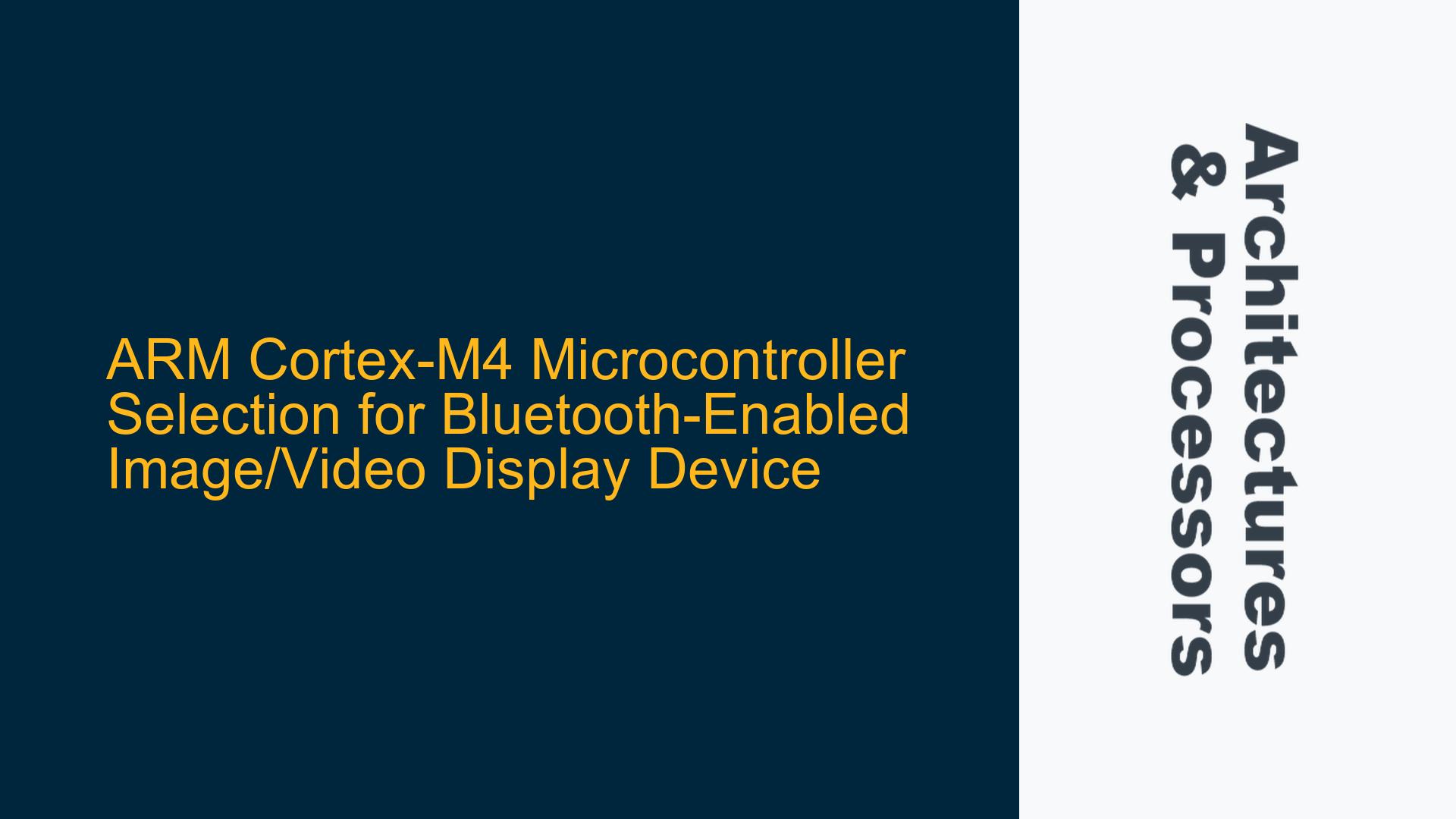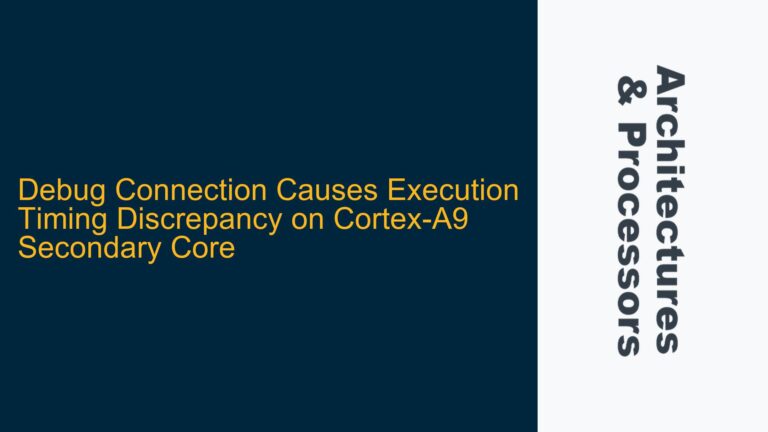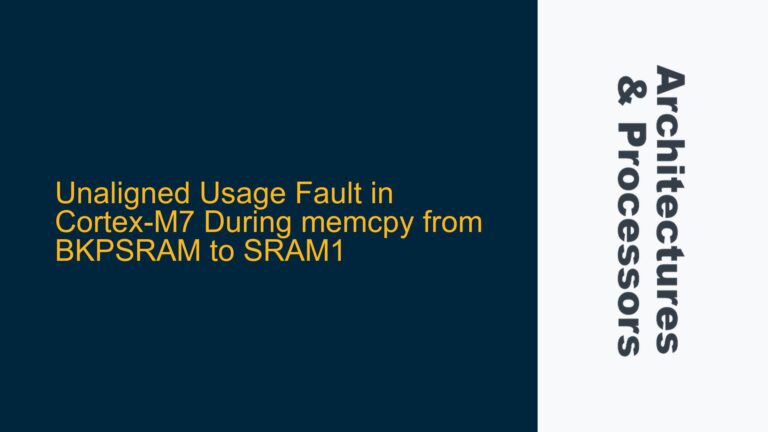ARM Cortex-M4 with DSP for Image/Video Processing and Bluetooth Integration
The core issue revolves around selecting an appropriate ARM Cortex-M4 microcontroller (MCU) that meets the requirements for a device capable of receiving images and videos via Bluetooth, storing them in external flash memory, and displaying them on an LCD screen. The device must operate independently of the smartphone once the data is transferred, meaning the microcontroller must handle data storage, retrieval, and display efficiently. The primary requirements include 32-bit architecture, Bluetooth Low Energy (BLE) 5.0 support, external flash memory connectivity, and compatibility with DRAM or SDRAM. Additionally, the MCU should ideally operate at 5V and have an optional onboard antenna.
The ARM Cortex-M4 is a strong candidate due to its DSP capabilities, which are beneficial for image and video processing tasks. However, the selection process must consider several factors, including memory management, Bluetooth integration, power consumption, and peripheral support. The discussion highlights the need for a microcontroller that can handle data-intensive tasks while maintaining low power consumption, a critical factor for battery-operated devices.
Memory Management and External Flash Storage Challenges
One of the primary challenges in this application is managing memory efficiently. The device must store up to 30 MB of video data in external flash memory, retrieve it when needed, and display it on an LCD screen. This requires the microcontroller to have robust memory management capabilities, including support for external memory interfaces and efficient data transfer mechanisms.
The Cortex-M4 typically includes a Memory Protection Unit (MPU) and supports external memory interfaces such as Quad-SPI (QSPI) for connecting to flash memory. However, the specific implementation details can vary between MCU vendors. For example, some Cortex-M4 MCUs may include a dedicated memory controller for external DRAM or SDRAM, while others may rely on general-purpose interfaces. The choice of external memory type (DRAM vs. SDRAM) can also impact performance and power consumption.
Another consideration is the file system used to manage data on the external flash memory. A lightweight file system such as FAT32 or SPIFFS may be suitable for this application, but the microcontroller must have sufficient processing power and memory to handle file system operations efficiently. The Cortex-M4’s DSP capabilities can be leveraged to optimize data transfer and processing, but careful configuration is required to avoid bottlenecks.
Bluetooth Low Energy (BLE) 5.0 Integration and Power Optimization
Integrating Bluetooth Low Energy (BLE) 5.0 into the device adds another layer of complexity. BLE 5.0 offers improved data transfer rates and range compared to previous versions, making it suitable for transferring image and video data. However, implementing BLE on a Cortex-M4 MCU requires careful consideration of power consumption, antenna design, and software stack compatibility.
Most Cortex-M4 MCUs with BLE support use an integrated radio or an external module. Integrated solutions are often more power-efficient and easier to design, but they may have limitations in terms of range and performance. External modules, on the other hand, offer greater flexibility but require additional design effort and may increase power consumption.
The choice of BLE stack is also critical. Many MCU vendors provide proprietary BLE stacks optimized for their hardware, while others support open-source solutions such as Zephyr or NimBLE. The selected stack must be compatible with the Cortex-M4 architecture and provide the necessary features for data transfer and device management.
Power optimization is another key consideration. BLE communication can be power-intensive, especially during data transfer. The Cortex-M4’s low-power modes and sleep states can help mitigate this, but the firmware must be carefully designed to balance performance and power consumption. Techniques such as dynamic frequency scaling and adaptive power management can be employed to optimize energy usage.
Peripheral Support and LCD Interface Requirements
The microcontroller must also support the necessary peripherals for interfacing with the LCD screen and other components. This includes GPIOs for control signals, SPI or I2C for communication, and possibly a dedicated display controller or graphics accelerator. The Cortex-M4’s flexible peripheral set makes it suitable for a wide range of applications, but the specific requirements of the LCD interface must be carefully evaluated.
For example, some LCD screens may require a parallel interface or a high-speed serial interface such as MIPI DSI. The microcontroller must have the necessary hardware support for these interfaces, or additional components such as bridge chips may be required. The choice of LCD technology (e.g., TFT, OLED) can also impact the design, as different technologies have varying power and performance characteristics.
Troubleshooting Steps, Solutions & Fixes
Evaluating Cortex-M4 MCUs with BLE 5.0 and External Memory Support
The first step in troubleshooting this issue is to evaluate available Cortex-M4 MCUs that meet the requirements for BLE 5.0, external memory support, and LCD interfacing. Popular options include the STM32 series from STMicroelectronics, the nRF52 series from Nordic Semiconductor, and the Kinetis series from NXP. Each of these MCUs has its strengths and weaknesses, and the choice will depend on the specific requirements of the application.
For example, the STM32F4 series offers robust peripheral support and a wide range of memory options, making it suitable for data-intensive applications. The nRF52 series, on the other hand, is optimized for BLE communication and offers excellent power efficiency. The Kinetis series provides a balance of performance and flexibility, with support for a wide range of peripherals and memory types.
Optimizing Memory Management and Data Transfer
Once a suitable MCU has been selected, the next step is to optimize memory management and data transfer. This involves configuring the external memory interface, selecting an appropriate file system, and implementing efficient data transfer mechanisms. For example, using DMA (Direct Memory Access) can significantly reduce the CPU load during data transfer, allowing the Cortex-M4 to focus on processing tasks.
The file system should be chosen based on the specific requirements of the application. For example, FAT32 is widely supported and easy to implement, but it may not be the most efficient option for small files. SPIFFS, on the other hand, is optimized for flash memory and can provide better performance for certain use cases.
Implementing Power-Efficient BLE Communication
To implement power-efficient BLE communication, the firmware must be designed to take advantage of the Cortex-M4’s low-power modes and sleep states. This includes using dynamic frequency scaling to reduce power consumption during periods of low activity and implementing adaptive power management to balance performance and energy usage.
The BLE stack should be configured to minimize power consumption during data transfer. This may involve adjusting the connection interval, reducing the transmit power, or using data compression techniques to reduce the amount of data that needs to be transferred.
Configuring Peripherals for LCD Interface
Finally, the peripherals must be configured to support the LCD interface. This includes setting up the necessary GPIOs, SPI or I2C interfaces, and any additional components such as bridge chips or display controllers. The firmware must be designed to handle the specific requirements of the LCD screen, including timing, resolution, and color depth.
For example, if the LCD screen requires a parallel interface, the microcontroller must be configured to support the necessary data and control signals. If a high-speed serial interface such as MIPI DSI is required, additional components such as a bridge chip may be needed to convert the signal to a format that the microcontroller can handle.
Testing and Validation
Once the hardware and firmware have been configured, the final step is to test and validate the system. This includes verifying that the external memory is functioning correctly, that data can be transferred efficiently over BLE, and that the LCD screen displays the images and videos as expected. Any issues that arise during testing should be addressed through further optimization and troubleshooting.
In conclusion, selecting and configuring an ARM Cortex-M4 microcontroller for a Bluetooth-enabled image/video display device involves careful consideration of memory management, BLE integration, power optimization, and peripheral support. By following the steps outlined above, it is possible to design a system that meets the requirements of the application while maintaining efficient performance and low power consumption.





